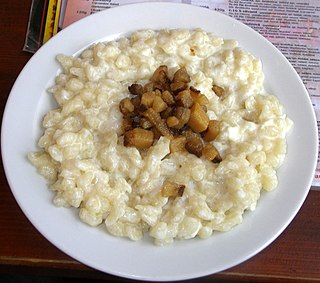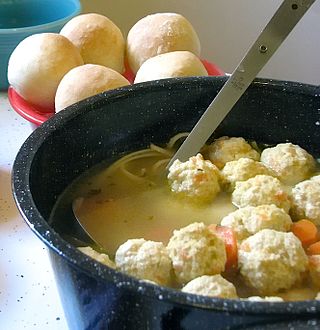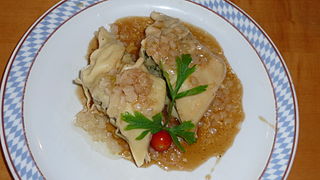
Zalewajka [1] is a traditional rustic soup made of diced and boiled potatoes and overflowed with sour rye made from sourdough bread. It also often contains Polish sausage and dried mushrooms.

Zalewajka [1] is a traditional rustic soup made of diced and boiled potatoes and overflowed with sour rye made from sourdough bread. It also often contains Polish sausage and dried mushrooms.
The soup comes from central part of Poland. The first mentions of it appeared in 19th century in Łódź and Radomsko. The basic component of diet for people from those areas were potatoes and mushrooms. Potatoes constituted the base of the majority of the dishes people from Łódź and Radomsko prepared. They were served in different ways like boiled, mashed or fried. Thanks to its simplicity in the 19th and 20th century zalewajka become popular around the country to places like Kielce and Zagłębię Dąbrowskie.

There are a lot of recipes for this kind of soup which are different because of the region of Poland they were prepared. [2]
Main ingredients of the soup is bread sourdough, water, sausages and onion slices. Also added are wheat flour, sour cream and potatoes. [3]
The potatoes are peeled, cut into small cubes, then put into water and boiled. Sliced sausages and chopped onion are fried on the pan. When the potatoes are almost boiled, sausage and bread sourdough are added. After careful mixing, flour with the sour cream and the pinch of salt is added. [4]
This recipe originated in the Świętokrzyskie region. It's quite similar to Łódź recipe, but garlic and bacon added and less of sour cream used. The cooking process itself is almost the same except putting bacon into the soup. [5]
Zalewajka from Radomsko is similar, but with more spices like marjoram and dried mushrooms. Cooked the same way as in the recipes from Łódź and Świętokrzyskie but without meat. [6]

A blood sausage is a sausage filled with blood that is cooked or dried and mixed with a filler until it is thick enough to solidify when cooled. Most commonly, the blood of pigs, sheep, lamb, cow, chicken, or goose is used.

Goulash is a soup or stew of meat and vegetables seasoned with paprika and other spices. Originating in Hungary, goulash is a common meal predominantly eaten in Central Europe but also in other parts of Europe. It is one of the national dishes of Hungary and a symbol of the country.

Polish cuisine is a style of cooking and food preparation originating in or widely popular in Poland. Due to Poland's history, Polish cuisine has evolved over the centuries to be very eclectic, and it shares many similarities with other regional cuisines. Polish-styled cooking in other cultures is often referred to as à la polonaise.

Pierogi are filled dumplings made by wrapping unleavened dough around a savory or sweet filling and cooking in boiling water. They are often pan-fried before serving.

Russian cuisine is a collection of the different dishes and cooking traditions of the Russian people as well as a list of culinary products popular in Russia, with most names being known since pre-Soviet times, coming from all kinds of social circles.

Lithuanian cuisine features products suited to the cool and moist northern climate of Lithuania: barley, potatoes, rye, beets, greens, berries, and mushrooms are locally grown, and dairy products are one of its specialties. Various ways of pickling were used to preserve food for winter. Soups are extremely popular, and are widely regarded as the key to good health. Since it shares its climate and agricultural practices with Northern Europe, Lithuanian cuisine has much in common with its Baltic neighbors and, in general, northern countries.

Ukrainian cuisine is the collection of the various cooking traditions of the people of Ukraine, one of the largest and most populous European countries. It is heavily influenced by the rich dark soil (chernozem) from which its ingredients come and often involves many components. Traditional Ukrainian dishes often experience a complex heating process – "at first they are fried or boiled, and then stewed or baked. This is the most distinctive feature of Ukrainian cuisine".

Slovak cuisine varies slightly from region to region across Slovakia. It was influenced by the traditional cuisine of its neighbours and it influenced them as well. The origins of traditional Slovak cuisine can be traced to times when the majority of the population lived self-sufficiently in villages, with very limited food imports and exports and with no modern means of food preservation or processing.
Norwegian cuisine in its traditional form is based largely on the raw materials readily available in Norway and its mountains, wilderness, and coast. It differs in many respects from continental cuisine through the stronger focus on game and fish. Many of the traditional dishes are the result of using conserved materials, necessary because of the long winters.

Czech cuisine has both influenced and been influenced by the cuisines of surrounding countries and nations. Many of the cakes and pastries that are popular in Central Europe originated within the Czech lands. Contemporary Czech cuisine is more meat-based than in previous periods; the current abundance of farmable meat has enriched its presence in regional cuisine. Traditionally, meat has been reserved for once-weekly consumption, typically on weekends.

Belarusian cuisine shares many similarities with cuisines of other Eastern, Central and Northeastern European countries, based predominantly on meat and various vegetables typical for the region.
In West Slavic countries, as well as in Belarus, fermented cereals, such as rye, wheat, or oatmeal, are used to make soups. In Poland and parts of Belarus, rye is traditional for making żur; a variant made with wheat flour instead of rye is known in Poland as barszcz biały. Fermented oatmeal is a common ingredient in Belarus and in some regions of Poland. Fermented wheat or sourdough soups are also found in other western Slavic cuisines, in particular in the Slovak (kyslovka), Silesian (Sauermehlsuppe) and Czech (kyselo) cuisines.

A meatball is ground meat rolled into a ball, sometimes along with other ingredients, such as bread crumbs, minced onion, eggs, butter, and seasoning. Meatballs are cooked by frying, baking, steaming, or braising in sauce. There are many types of meatballs using different types of meats and spices. The term is sometimes extended to meatless versions based on vegetables or fish; the latter are also commonly known as fishballs.

Northern Irish cuisine encompasses the cooking styles, traditions and recipes associated with Northern Ireland. It has distinctive attributes of its own, but has also drawn heavily from Irish and British cuisines.

Swabian cuisine is native to Swabia, a region in southwestern Germany comprising great parts of Württemberg and the Bavarian part of Swabia, as well as the Allgäu which has parts lying in Austria. Swabian cuisine has a reputation for being rustic, but rich and hearty. Fresh egg pastas, soups, and sausages are among Swabia's best-known types of dishes, and Swabian cuisine tends to require broths or sauces; dishes are rarely "dry".
Podlaskie cuisine is an umbrella term for all dishes with a specific regional identity belonging to the region of Podlaskie. It is a subtype of Polish, Lithuanian and Belarusian cuisine with many similarities to and signs of the influence of neighbouring cuisines.